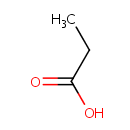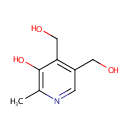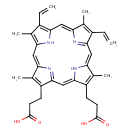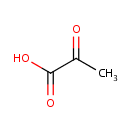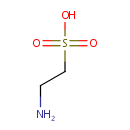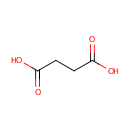
Search Results for compounds
Searching compounds for
returned 4373 results.
Propionic acid (PAMDB000098)
IUPAC:
propanoic acid
CAS: 79-09-4
Description: Propionic acid (PA) is a naturally-occurring carboxylic acid with chemical formula CH3CH2COOH. It is a clear liquid with a pungent odor. The anion CH3CH2COO
Pyridoxine (PAMDB000099)
IUPAC:
4,5-bis(hydroxymethyl)-2-methylpyridin-3-ol
CAS: 65-23-6
Description: Pyridoxine is a weakly basice pyridine deriviative. It is a member of the B6 vitamins. The biosynthesis of pyridoxine has classically been studied in Pseudomonas aeruginosa where the precursors 4-phosphohydroxy-L-threonine and 1-deoxy-D-xylulose-5-phosphate (DXP) are converted to pyridoxinephosphate by the action of the protein encoded by pdxJ. Pseudomonas aeruginosa can also take up exogenous forms of vitamin B6 and trap them in the cytoplasm by phosphorylation. This requires the function of a kinase encoded by pdxK and of the pyridoxal reductase Plr1.
Sulfite (PAMDB000100)
IUPAC:
sulfurous acid
CAS: 14265-45-3
Description: Sulfite is a doubly negatively charged anion containing 1 sulfur and 3 oxygens. Endogenous sulfite is generated as a consequence of the normal processing of sulfur-containing amino acids. In E.coli, sulfites are involved in 3 metabolic pathways: cysteine and methionine metabolism, taurine and hypotaurine metabolims and sulfur metabolism. (KEGG)
Protoporphyrin IX (PAMDB000101)
IUPAC:
3-[20-(2-carboxyethyl)-9,14-diethenyl-5,10,15,19-tetramethyl-21,22,23,24-tetraazapentacyclo[16.2.1.1?,??1????.1??,???tetracosa-1(21),2,4,6,8(23),9,11,13,15,17,19-undecaen-4-yl]propanoic acid
CAS: 553-12-8
Description: Protoporphyrins are tetrapyrroles containing 4 methyl, 2 propionic and 2 vinyl side chains. Protopophyrin is produced by oxidation of the methylene bridge of protoporphyrinogen. Protoporphyrin IX is the only naturally occurring isomer; it is an intermediate in heme biosynthesis, combining with ferrous iron to form protoheme IX, the heme prosthetic group of hemoglobin. Protoporphyrin IX is created by the enzyme protoporphyrinogen oxidase. The enzyme ferrochelatase converts it into heme. Protoporphyrin IX naturally occurs in small amounts in feces. It is accumulated and excreted excessively in the feces in protoporphyria and variegate porphyria. Protoporphyrin IX is also responsible for the brown pigment (Ooporphyrin) of birds' eggs Protoporphyrin IX is used as a branch point in the biosynthetic pathway leading to Heme (by insertion of iron) and chlorophylls (by insertion of Mg and further side-chain transformation).
Pyruvic acid (PAMDB000102)
IUPAC:
2-oxopropanoic acid
CAS: 127-17-3
Description: Pyruvic acid is an alpha-keto acid. It can be made from glucose through glycolysis, converted back to carbohydrates (such as glucose) via gluconeogenesis, or to fatty acids through acetyl-CoA. It can also be used to construct the amino acid alanine and be converted into ethanol. Pyruvic acid supplies energy to living cells through the citric acid cycle (also known as the Krebs cycle) when oxygen is present (aerobic respiration), and alternatively ferments to produce lactic acid when oxygen is lacking (fermentation).
Riboflavin (PAMDB000103)
IUPAC:
7,8-dimethyl-10-[(2S,3S,4R)-2,3,4,5-tetrahydroxypentyl]-2H,3H,4H,10H-benzo[g]pteridine-2,4-dione
CAS: 83-88-5
Description: Riboflavin, also known as vitamin B2, is the central component of the cofactors FAD and FMN, and is therefore required by all flavoproteins. As such, vitamin B2 is required for a wide variety of cellular processes. Like the other B vitamins, it plays a key role in energy metabolism, and is required for the metabolism of fats, ketone bodies, carbohydrates, and proteins. (Wikipedia)
Porphobilinogen (PAMDB000104)
IUPAC:
3-[5-(aminomethyl)-4-(carboxymethyl)-1H-pyrrol-3-yl]propanoic acid
CAS: 487-90-1
Description: Porphobilinogen is a pyrrole involved in porphyrin metabolism. -- Wikipedia; It consists of a pyrrole ring with acetyl, propionyl, and aminomethyl side chains; It is a key monopyrrolic intermediate in porphyrin, chlorophyll and vitamin B12 biosynthesis. Porphobilinogen is generated by the enzyme ALA dehydratase by combining two molecules of dALA together, and converted into hydroxymethyl bilane by the enzyme porphobilinogen deaminase. 4 molecules of porphobilinogen are condensed to form one molecule of uroporphyrinogen I, which is then converted successively to coproporphyrinogen I, protoporphyrin IX, and heme.
Taurine (PAMDB000106)
IUPAC:
2-aminoethane-1-sulfonic acid
CAS: 107-35-7
Description: Taurine is a sulfur amino acid like methionine, cystine, cysteine and homocysteine. It is a lesser-known amino acid because it is not incorporated into the structural building blocks of protein. Taurine has many diverse biological functions serving as a stabilizer of cell membranes and a facilitator in the transport of ions such as sodium, potassium, calcium and magnesium.
Succinic acid (PAMDB000107)
IUPAC:
butanedioic acid
CAS: 110-15-6
Description: Succinic acid is a dicarboxylic acid. The anion, succinate, is a component of the citric acid cycle capable of donating electrons to the electron transfer chain. SDH with a covalently attached FAD prosthetic group, binds enzyme substrates (succinate and fumarate) and physiological regulators (oxaloacetate and ATP). Oxidizing succinate links SDH to the fast-cycling Krebs cycle portion where it participates in the breakdown of acetyl-CoA throughout the whole Krebs cycle.
Thiosulfate (PAMDB000108)
IUPAC:
dihydroxy-1???disulfen-1-one
CAS: 14383-50-7
Description: Thiosulfate occurs naturally in hot springs and geysers, and is produced by certain biochemical processes. Thiosulfate is an intermediate in several biochemical pathways, including the synthesis of L-cysteine. Thiosulfate is manufactured by some cells by oxidation of elemental sulfur and by degradation of L-cysteine.
